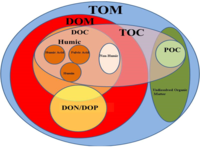
Photo from wikipedia
Soil respiration (SR TOT ) and its main components, soil heterotrophic (SR H ) and autotrophic respiration (SR A ), were monitored in response to within-season drought events of increasing… Click to show full abstract
Soil respiration (SR TOT ) and its main components, soil heterotrophic (SR H ) and autotrophic respiration (SR A ), were monitored in response to within-season drought events of increasing duration and soil N enrichment in a semiarid meadow steppe. The experiment consisted of the combination of five drought periods (0 days, 15 days, 30 days, 45 days, and 60 days) and two N addition levels (0 and 10 g N m −2 year −1 applied as urea). Soil respiration decreased after 30 days of drought, with the response being driven by soil heterotrophs. Moreover, N addition increased the sensitivity of soil respiration to soil water content, which we attributed to greater plant C inputs and soil microbial C and N content in the N addition treatment. Our results highlight the role of SR H as a key regulator of C fluxes in nutrient-poor semiarid meadow steppe in response to extreme within-season drought and the role of soil N availability in modulating this response.
Journal Title: Biology and Fertility of Soils
Year Published: 2020
Link to full text (if available)
Share on Social Media: Sign Up to like & get
recommendations!